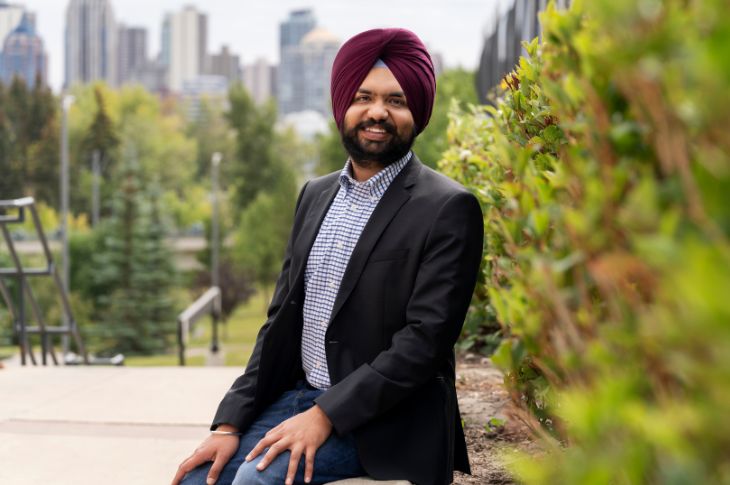Tejeshwar (Tej) Grewal
Bachelor of Applied Technology Petroleum Engineering '18, SAIT MacPhail School of Energy
Vice President of Innovation, Qube Technologies
For as long as he can remember, Tejeshwar (Tej) Grewal has begun each day with a Sikh prayer from the Guru Granth Sahib: Pavan guroo paanee pitaa. Maataa Dharat mahat. Translated to English, it means, "Air is the Guru. Water is the Father. Earth is the great Mother of all."
Speaking those same words aloud every morning, Grewal says, instills in him a passion for protecting the planet.
Just like the prayer, Grewal’s innovation started with a focus on the air. In 2016, while taking an environmental class at SAIT as an international student from India, he learned about the many orphaned wells that bankrupt oil and gas companies were unable to shut off or adequately maintain. "I thought the least we could do was monitor these wells for leaks and identify the highest priorities for remediation," he says.
So Grewal set out to design a rudimentary, low-cost, continuous remote monitoring device that uses environmental sensors combined with artificial intelligence (AI) to detect and measure hazardous greenhouse gas leaks. He first pitched his idea to potential investors at a SAIT industry night and, not long after graduating, became co-founder of a cleantech startup called Qube Technologies.
The company has grown into a market leader for emissions detection technology, enhancing and adapting Grewal's original design to work in a range of rugged and remote industrial settings. Today, more than 2,000 Qube industrial Internet of Things (IoT) devices are installed at sites worldwide to detect, measure and report levels of carbon dioxide, methane, hydrogen sulfide, VOCs (volatile organic compounds) and other emissions.
While protecting the environment has always been Grewal's first concern, he says early detection of leaks also makes good business sense. "When oil and gas companies are alerted as soon as a leak occurs, they can make repairs more quickly and efficiently,” he explains. “It means those companies are able to sell millions of dollars of product rather than losing it in the air and causing a negative impact on the environment.”
Finding solutions that provide for a sustainable future without disrupting economies is something Grewal sees himself continuing — potentially in ways that address pollution of the two remaining elements in his morning prayer: water and the Earth.
Grewal’s achievements have led him to being named to Forbes magazine’s 2023 Top 30 Under 30 — Energy list, and as a 2023 SAIT Outstanding Young Alumnus. "I feel very lucky to be recognized, especially as an immigrant,” he says. “I'm so thankful for the many mentors I've had at SAIT and the many people who have been part of this. It feels like a dream come true."
Learn more about Tej Grewal

Oki, Âba wathtech, Danit'ada, Tawnshi, Hello.
SAIT is located on the traditional territories of the Niitsitapi (Blackfoot) and the people of Treaty 7 which includes the Siksika, the Piikani, the Kainai, the Tsuut’ina and the Îyârhe Nakoda of Bearspaw, Chiniki and Goodstoney.
We are situated in an area the Blackfoot tribes traditionally called Moh’kinsstis, where the Bow River meets the Elbow River. We now call it the city of Calgary, which is also home to the Métis Nation of Alberta.
